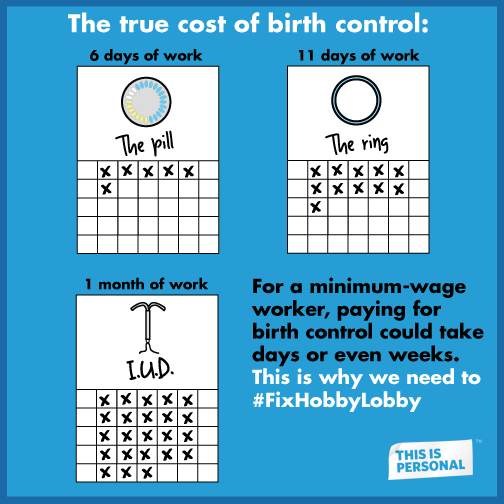Abortion rights, women of color, and LGBTQI+ people are under attack. Pledge to join us in fighting for gender justice.
#WorstTBTEver: When There Was an Unmet Need for Birth Control Coverage

 In this week’s #WorstTBTEver blog series, we are discussing one of the most popular and successful provisions of the Affordable Care Act (ACA), also known as Obamacare: the birth control benefit.
In this week’s #WorstTBTEver blog series, we are discussing one of the most popular and successful provisions of the Affordable Care Act (ACA), also known as Obamacare: the birth control benefit.
The ACA’s birth control benefit requires all new health plans to cover at least one form of birth control in each of the 18 categories of birth control methods approved by the Food and Drug Administration (FDA) with no out-of-pocket costs like deductibles, co-payments, and co-insurance.
This has been a game changer for women, but members in the House of Representatives have made clear that if the ACA is repealed, they will not replace the birth control benefit; Tom Price, the nominee for Secretary of Health and Human Services, has ardently denied that women need coverage for birth control; and Neil Gorsuch, the administration’s pick for the Supreme Court, joined the lower court decision that laid the groundwork for the Supreme Court’s now infamous Hobby Lobby decision allowing employers to use their religious beliefs to block their employees’ access to birth control coverage.
These politicians have all but promised that if the ACA is repealed, women will be thrown back to a time when there was no guarantee they could afford the most appropriate birth control method for them.
What was it like for women before the birth control benefit?
Prior to the ACA, there was a patchwork system of legal requirements that helped make sure some women had access to insurance coverage of birth control. Twenty-eight states required coverage in private plans; the federal non-discrimination in employment law required employers governed by that law to provide it, and Medicaid required coverage in the state Medicaid programs. But this patchwork system wasn’t enough – none of these requirements guaranteed the full range of contraceptive methods would be covered and, with the exception of Medicaid, none required that birth control was available without cost-sharing.
That meant women had unmet needs when it came to birth control. Prior to the ACA, costs of birth control made up 30-44% of women’s total out-of-pocket health care costs. For someone making the federal minimum wage of $7.25, the average cost of a full year’s worth of birth control pills without insurance was the equivalent of 51 hours of work. The up-front costs of an IUD (around $1,000), one of the most effective birth control methods, was nearly a month’s salary for someone working full-time at minimum wage. These costs were prohibitive for millions of women—in fact, one study found that co-pays as little as $6 per month were associated with the discontinuance of birth control.
This led women to use birth control incorrectly or inconsistently or to forgo it altogether, contributing to the nation’s high unintended pregnancy rate with accompanying risks to the health of women and children. It also meant some women couldn’t prevent, plan, and space pregnancies, hurting their ability to move forward in their education and career.
Why has the birth control benefit been a game-changer for women?
By eliminating cost barriers and requiring coverage of all methods plus related education and counseling, the ACA’s birth control benefit revolutionized women’s access to birth control. In just over a year of the birth control benefit, one study found that the percentage of women getting an IUD with no out of pocket costs increased to 62 percent. Express Scripts, one of the nation’s largest pharmaceutical management companies, saw an increased use of oral birth control pills that it attributed to the ACA birth control benefit meeting an unmet need.
Thanks to the ACA’s birth control benefit, women no longer have to have to sacrifice their financial wellbeing in order to get the most appropriate method of birth control. In just one year, the ACA’s birth control benefit saved women $1.4 billion on birth control pills alone—this doesn’t even include the savings from more expensive methods such as IUDs.
And other data aren’t in yet, but we expect to see benefits to public health as well such as decreases in unintended pregnancy and better health outcomes for women and children.
We won’t go back
The ACA’s birth control benefit has truly been a game-changer for women’s access to affordable birth control. We cannot go back to a time when women lacked access to birth control coverage because of where they lived or what insurance they had. And we cannot go back to a time when millions of women faced cost barriers to the birth control method of their choice. Women across the nation need the birth control benefit. And we are ready to fight for it.
Don’t miss our other #WorstTBTEver blogs:
Post 1: When Millions of Women Fell into the Coverage Gap
Post 2: When Being a Woman Was a Pre-Existing Condition
Post 3: When Health Insurance was Out of Reach
Post 4: When Your Zip Code Determined Whether You Could Get Affordable, Comprehensive* Health Insurance





